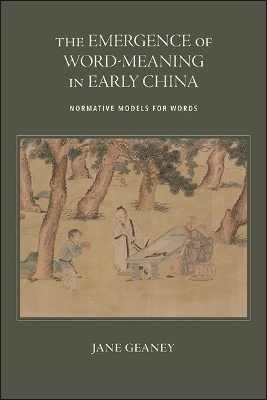
The Emergence of Word-Meaning in Early China
State University of New York Press (Verlag)
978-1-4384-8894-3 (ISBN)
The Emergence of Word-Meaning in Early China makes an innovative contribution to studies of language by historicizing the Chinese notion that words have "meaning" (content independent of instances of use). Rather than presuming that the concept of word-meaning had always existed, Jane Geaney explains how and why it arose in China. To account for why a normative term (yi, "duty, morality, appropriateness") came to be used for "meanings" found in dictionaries, Geaney examines interrelated patterns of word usage threading through and across a wide range of genres. These patterns show that by the first millennium, as textual production exploded—and as radically different writing forms (in Buddhist sutras) were encountered—yi already functioned as an externally accessible "model" for semantic interpretation of texts and sayings.
The book has far-reaching implications. Because the idea of word-meaning is fundamental to theorizing, the book illuminates not only semantic ideas and the normativity of language in Early China, but also aspects of early Chinese philosophy and intellectual history. As the internet supplants one form of media (print), thereby reducing knowledge to vast digital databases, so too, this book explains, two thousand years ago a culture that prized oral and visual balance became an "empire of the text."
Jane Geaney is Professor of Religious Studies at the University of Richmond. She is the author of Language as Bodily Practice in Early China: A Chinese Grammatology, also published by SUNY Press, and On the Epistemology of the Senses in Early Chinese Thought.
Acknowledgments
Introduction: General Context
Part I: Key Metalinguistic Terms and Yi 義 as External
1. The Metalinguistic Implications of Words versus Names
2. Speech (Yan 言) from Within and Names (Ming 名) from Without
3. Yi 意 and the Heartmind's Activities
4. The Externality of Yi 義
5. The Resilience of the Externality of Yi 義
Part II: Yi 義 as Model
6. Yi 義 as Model: Stable, Accessible Standards
7. Yi 義 as Model in Diagrams, Genres, Figurative Language, and Names
8. A Framework Preceding the Shuowen's Metalinguistic Choices
9. Yi 義 Justifying with Models
10. Yi 義 in the Shuowen Jiezi
Conclusion
Appendix A: Why Translate Yi 義 as "Model"?
Appendix B: Yi 義's Externality in Dispute: The Mengzi and the Mo Bian
Appendix C: Glossary of Terms with Aural or Visual Associations
Bibliography
Index
| Erscheinungsdatum | 19.12.2022 |
|---|---|
| Reihe/Serie | SUNY series in Chinese Philosophy and Culture |
| Zusatzinfo | Total Illustrations: 0 |
| Verlagsort | Albany, NY |
| Sprache | englisch |
| Maße | 178 x 254 mm |
| Gewicht | 227 g |
| Themenwelt | Geisteswissenschaften ► Geschichte ► Regional- / Ländergeschichte |
| Geisteswissenschaften ► Philosophie ► Östliche Philosophie | |
| Geisteswissenschaften ► Philosophie ► Sprachphilosophie | |
| ISBN-10 | 1-4384-8894-7 / 1438488947 |
| ISBN-13 | 978-1-4384-8894-3 / 9781438488943 |
| Zustand | Neuware |
| Haben Sie eine Frage zum Produkt? |
aus dem Bereich


